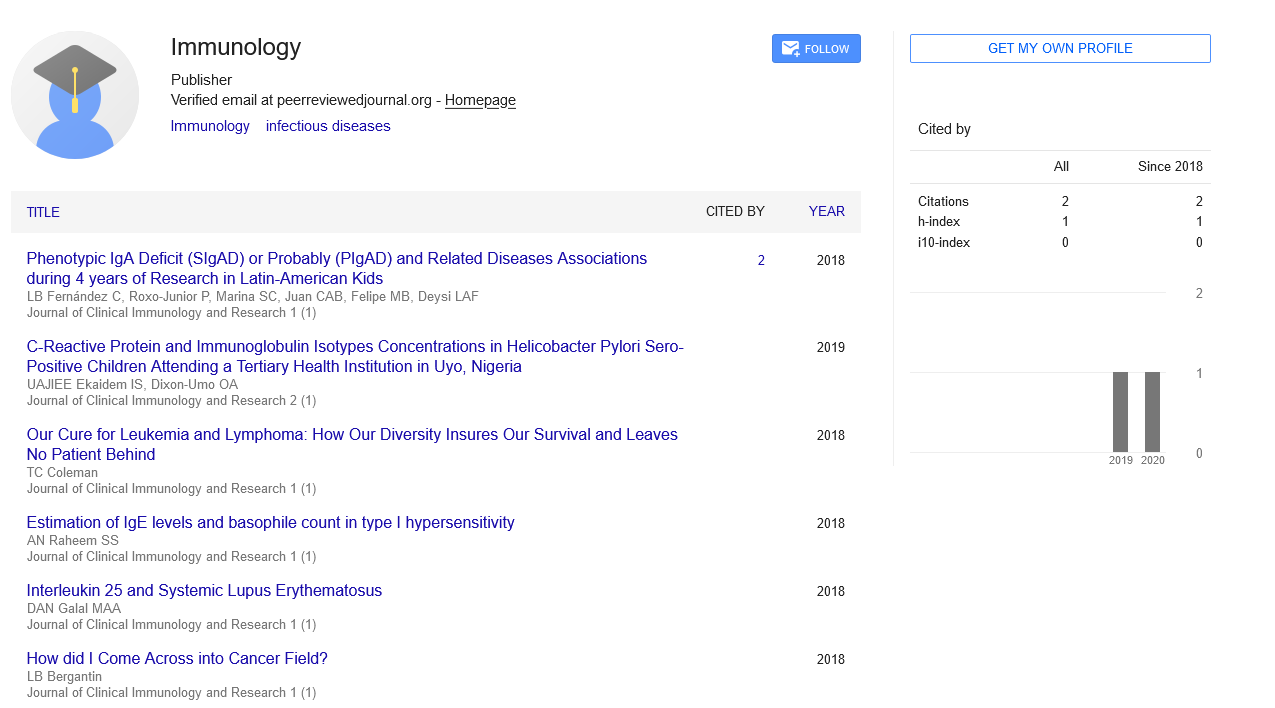Editorial, J Clin Immunol Res Vol: 4 Issue: 3
Short Lived Plasma Cells
Arena Lac*
Department of Biochemistry, USA, Sweden Medical College, USA
*Corresponding author: Arena L, Department of Biochemistry, USA, Sweden Medical College, USA; E-mail: arenal676@gmail.com
Received date: June 02, 2021; Accepted date: June 14, 2021; Published date: June 26, 2021
Keywords: Base Excision Repair
Introduction
Carrier of genetic instructions utilized in development, functioning and reproduction of all leaving organisms could even be a macromolecule called DNA. Alteration in chemical structure of DNA is DNA damage. It’s due to two sorts of factors-Endogenous and Exogenous. DNA impairment affects genital system, circulatory system, system lymphaticum , system nervous and causes cancer, ageing and various diseases. DNA is repaired by various ways like Base Excision Repair (BER), Nucleotide Excision Repair (NER), Mismatch Excision Repair (MMR) and Double Strand Break Repair (DSBR). BER mechanism is employed when DNA is suffering from reactive oxygen species, alkylating agents by oxidation or single strand break. This mechanism involves removal of base then replacement. NER mechanism is employed when DNA is suffering from UV light and polycyclic aromatic hydrocarbons by forming bulky adducts and intra-strand crosslink. This mechanism involves removal of DNA fragment and replacement. MMR mechanism is employed when mismatch occurs within bases like A-G pair and T-C pair. This acted by removal of strand followed by digestion and replacement. DSBR is another repair mechanism for damaged DNA by Homologous and Non-Homologous end joining. It includes unwinding, alignment and Ligation. During this Review we'll study about DNA repair mechanisms and its consequences. DNA contains mainly three components viz. Pentose Sugar, Nitrogen Base and Phosphate group. DNA determines the expansion, development function and reproduction in living beings. It’s mainly macromolecule and proteins, lipids and carbohydrates too. These macromolecules are essential for living beings. It’s two strands coiled around one another forming a double helix structure. Since, two strands are formed from monomer units called nucleotides, they're termed as polynucleotides. Nucleotide is aggregation of nitrogen bases like Purines (A,G) and Pyrimidines (C,T,U), Deoxyribose sugar and Phosphate group Direct reversal of DNA damage could also be a mechanism of repair that does not require a template and is applied to 2 main sorts of damage. UV light induces the formation of pyrimidine dimers which may distort the DNA chain structure, blocking transcription beyond the earth of injury .Direct reversal through photoreactivation can inverse this dimerization reaction by utilizing light energy for the destruction of the abnormal bond between adjacent pyrimidine bases. this type of photo reactivation doesn't occur in humans. The damage caused by alkylating agents reacting with DNA also can be repaired through direct reversal. Methylation of guanine bases produces a change within the structure of DNA by forming a product that's complimentary to thymine rather than cytosine. The protein methyl guanine methyl transferase (MGMT) can restore the first guanine by transferring the methylation product to its site. We wished to figure out the effect of NER, including TCR, on the kinds and locations of mutations that are induced by UV in an endogenous target gene in human cells. to undertake to the present , it is necessary to figure out the repair characteristics of the most photoproducts within the individual strands of a target gene which can even be used for mutagenesis studies. The hypoxanthine (guanine) phosphoribosyltransferase (HPRT) gene was chosen for these studies because it's transcriptionally active, there's only one active copy because of its location on the X chromosome, and thus the thioguanine assay could also be a convenient selection system for mutations that affect enzyme function This assay is based on the actual fact that HPRT is required for metabolism of the purine analog 6-thioguanine to a cytotoxic product, but the enzyme isn't required for normal cell growth. Therefore, if a population of cells is plated within the presence of thioguanine, cells with mutant HPRT will grow during a clonal fashion whereas the cells expressing functional HPRT enzyme die. The mutant clones are often easily identified for subsequent genetic analysis. What does DNA got to do with cancer? Cancer occurs when cells divide in an uncontrolled way, ignoring normal "stop" signals and producing a tumor. This bad behavior is caused by accumulated mutations, or permanent sequence changes within the cells' DNA. Replication errors and DNA damage are literally happening within the cells of our bodies all the time. In most cases, however, they don’t cause cancer, or maybe mutations. That’s because they're usually detected and glued by DNA proofreading and repair mechanisms. Or, if the damage cannot be fixed, the cell will undergo programmed necrobiosis (apoptosis) to avoid passing on the faulty DNA. Mutations happen, and acquire passed on to daughter cells, only these mechanisms fail. Cancer, in turn, develops only multiple mutations in division-related genes accumulate within the same cell. During this text, we’ll take a much better inspect the mechanisms employed by cells to correct replication errors and fix DNA damage, including. Proofreading, which corrects errors during DNA replication Mismatch repair, which fixes mispaired bases right after DNA replication DNA damage repair pathways, which detect and proper damage throughout the cell cycle.
 Spanish
Spanish  Chinese
Chinese  Russian
Russian  German
German  French
French  Japanese
Japanese  Portuguese
Portuguese  Hindi
Hindi 